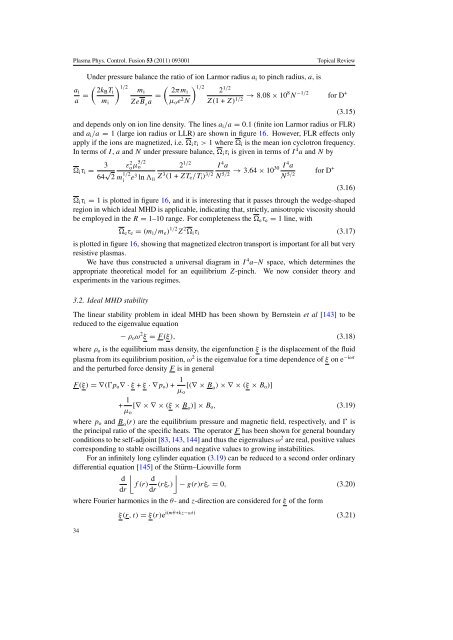You also want an ePaper? Increase the reach of your titles
YUMPU automatically turns print PDFs into web optimized ePapers that Google loves.
Plasma Phys. Control. Fusion 53 (2011) 093001<br />
Topical Review<br />
Under pressure balance <strong>the</strong> ratio <strong>of</strong> ion Larmor radius a i to <strong>pinch</strong> radius, a, is<br />
( )<br />
a i<br />
a = 2kB T 1/2 ( )<br />
i m 1/2<br />
i<br />
m i ZeB θ<br />
a = 2πmi 2 1/2<br />
µ o e 2 N Z(1+Z) → 8.08 × 1/2 108 N −1/2 for D +<br />
(3.15)<br />
and depends only on ion line density. The lines a i /a = 0.1 (finite ion Larmor radius or FLR)<br />
and a i /a = 1 (large ion radius or LLR) are shown in figure 16. However, FLR effects only<br />
apply if <strong>the</strong> ions are magnetized, i.e. i τ i > 1 where i is <strong>the</strong> mean ion cyclotron frequency.<br />
In terms <strong>of</strong> I, a and N under pressure balance, i τ i is given in terms <strong>of</strong> I 4 a and N by<br />
i τ i = 3<br />
64 √ 2<br />
εo 2µ5/2<br />
o<br />
m 1/2<br />
2 1/2 I 4 a<br />
i<br />
e 3 ln ii<br />
Z 3 (1+ZT e /T i ) 3/2 N → 3.64 × I 4 a<br />
5/2 1030 for D +<br />
N 5/2 (3.16)<br />
i τ i = 1 is plotted in figure 16, and it is interesting that it passes through <strong>the</strong> wedge-shaped<br />
region in which ideal MHD is applicable, indicating that, strictly, anisotropic viscosity should<br />
be employed in <strong>the</strong> R = 1–10 range. For completeness <strong>the</strong> e τ e = 1 line, with<br />
e τ e = (m i /m e ) 1/2 Z 2 i τ i (3.17)<br />
is plotted in figure 16, showing that magnetized electron transport is important for all but very<br />
resistive plasmas.<br />
We have thus constructed a universal diagram in I 4 a–N space, which determines <strong>the</strong><br />
appropriate <strong>the</strong>oretical model for an equilibrium Z-<strong>pinch</strong>. We now consider <strong>the</strong>ory and<br />
experiments in <strong>the</strong> various regimes.<br />
3.2. Ideal MHD stability<br />
The linear stability problem in ideal MHD has been shown by Bernstein et al [143] tobe<br />
reduced to <strong>the</strong> eigenvalue equation<br />
− ρ o ω 2 ξ = F (ξ), (3.18)<br />
where ρ o is <strong>the</strong> equilibrium mass density, <strong>the</strong> eigenfunction ξ is <strong>the</strong> displacement <strong>of</strong> <strong>the</strong> fluid<br />
plasma from its equilibrium position, ω 2 is <strong>the</strong> eigenvalue for a time dependence <strong>of</strong> ξ on e −iωt<br />
and <strong>the</strong> perturbed force density F is in general<br />
F (ξ) =∇(Ɣp o ∇·ξ + ξ ·∇p o ) + 1 µ o<br />
[(∇ ×B o ) ×∇×(ξ × B o )]<br />
+ 1 µ o<br />
[∇×∇×(ξ × B o )] × B o , (3.19)<br />
where p o and B o (r) are <strong>the</strong> equilibrium pressure and magnetic field, respectively, and Ɣ is<br />
<strong>the</strong> principal ratio <strong>of</strong> <strong>the</strong> specific heats. The operator F has been shown for general boundary<br />
conditions to be self-adjoint [83, 143, 144] and thus <strong>the</strong> eigenvalues ω 2 are real, positive values<br />
corresponding to stable oscillations and negative values to growing instabilities.<br />
For an infinitely long cylinder equation (3.19) can be reduced to a second order ordinary<br />
differential equation [145] <strong>of</strong> <strong>the</strong> Stürm–Liouville form<br />
d<br />
dr<br />
⌊<br />
f(r) d dr (rξ r)<br />
⌋<br />
− g(r)rξ r = 0, (3.20)<br />
where Fourier harmonics in <strong>the</strong> θ- and z-direction are considered for ξ <strong>of</strong> <strong>the</strong> form<br />
34<br />
ξ(r,t)= ξ(r)e i(mθ+kz−ωt) (3.21)














